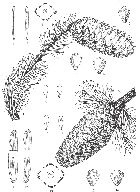
Line drawing; for full size image go to the Flora of China (Wu and Raven 1999).
Picea crassifolia
Qinghai spruce; 青海云杉 Qinghai yunshan [Chinese] (Farjon 1990).
Syn: P. schrenkiana var. crassifolia (Komarov) Komarov; P. complanata var. crassifolia (Komarov) Gaussen (Farjon 1990).
Trees up to 25 m tall and 60 cm dbh. Branchlets greenish yellow, turning pink or brownish yellow. Leaves radially inserted, often ascending on upper side of branchlets, stout, quadrangular in cross section, 12-35×2-3 mm, stomata in 5-7 lines above and 4-6 lines beneath the leaf. Seed cones cylindric, 7-11×2-3.5 cm. Seed scales obovate, slightly incurved, 1.8×1.5 cm, margin entire, slightly undulate, apex rounded. Seeds obliquely obovoid, 3.5 mm long, with a 9 mm wing. Pollination Apr-May, seed maturity Sep-Oct (Wu and Raven 1999).
China: Nei Mongol (Helan Shan, Daqing Shan), Gansu, Ningxia, NE Qinghai (Qilian Shan, and around Qinghai Hu). In mountains, at 1600-3800 m elevation (Farjon 1990, Wu and Raven 1999). Hardy to Zone 5 (cold hardiness limit between -28.8°C and -23.3°C) (Bannister and Neuner 2001).
The epithet means "having thick leaves."
Farjon, Aljos. 1990. Pinaceae: drawings and descriptions of the genera Abies, Cedrus, Pseudolarix, Keteleeria, Nothotsuga, Tsuga, Cathaya, Pseudotsuga, Larix and Picea. Königstein: Koeltz Scientific Books.
Komarov, V. L. 1923. De Gymnospermis nonnullis Asiaticis I. Bot. Mater. Gerb. Glavn. Bot. Sada RSFSR 4: 177.
Last Modified 2025-02-10